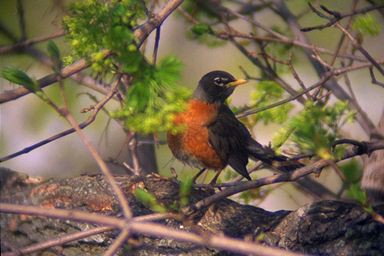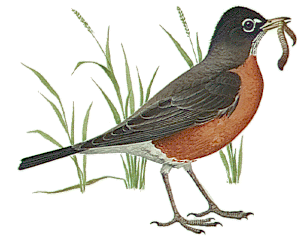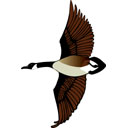
|
|
|
|

The American Robin is called the "harbinger of Spring" because of it's early northward migration which brings its arrival before most other migratory birds. Because of its size and song, along with its habit of living close to human development, it is usually the first of the summer birds to be noticed by us. Weather predictions of an early spring are based on the time that the robin arrives at its northern nesting sites. Seeing the first robin of spring always brings a smile to your face and gives you thoughts of warm summer days ahead.
The American Robin is our Michigan State bird but did you know that it is also the State bird of Connecticut and Wisconsin? Our Robin is noted for its beautiful red breast and loud cheery song. It was first called Robin by the early colonists, in remembrance of their beloved English bird. Despite the protests of some naturalists, we still retain that traditional name today.
The American or Canadian robin,
a true thrush, is one of the largest and most numerous of American thrushes,
with a body about 25 cm (about 10 in) long. The male is olive-gray; the
top and sides of the head are black with a split white eye-ring, the chin
and throat are white with black streaks, and the breast and underparts
are reddish orange, the bill is yellow. The female is browner above and
of duller hues below. The juveniles are plump and heavily spotted with
a rusty wash. Its nest is built of coarse grass and reeds, plastered
inside with mud and lined with grasses. The eggs, laid in a clutch of four
to five, are a uniform greenish blue.
![]()
In an interesting article in the latest Birders
World I learned that Robins have been a sort of "early warning" signal
for us in recent years. Back in the 1950's and '60's, DDT was being actively
sprayed in our neighborhoods to curb the elm bark beetle that was transmitting
the dreaded Dutch Elm disease to our stately old American Elms. DDT is
a chemical made by man that can neither be broken down within, nor
excreted from, living organisns. Well, it wasn't long before earthworms
beneath the trees consumed the chemical and it became concentrated in their
bodies. Robins then consumed those earthworms, further concentrating the
DDT to the point that it became lethal to them. Robins were actually being
found dying on people's lawns. Ornithologist George Wallace from Michigan
State University observed the catastrophe and sounded the alarm to us all.
So the Robin, with their very lives, served as an early warning to us of
DDT's potential threat to humans. Fortunately, we heeded the warning and
in 1972 banned the use of DDT throughout the United States.
Robin populations have certainly recovered
from this era and have even expanded their breeding and wintering ranges.
Robins seem to be staying farther north* in the winter and even in
areas that they leave, they seem to be staying longer in the fall and returning
earlier in the spring. These birds are limited by the cold weather. When
the ground is snow-covered or frozen, they cannot feed on worms, which
burrow down below the freeze line for the winter. Robin diets are
normally about 60% fruit so they can subsist on berries but there IS a
limit to their cold tolerance.
Since Robins seem to be wintering farther
and farther north, could it be that they are once again telling us something
about our environment? While scholars debate the reality of global warming,
perhaps we should again heed the Robin's "early warning."
*Reports of Robins remaining here in Michigan
this winter is evidenced by the many Christmas Bird counts. The Macomb
Audubon Society's CBC listed 98 American Robins on December 19th, 1998,
a new high for this count.
![]()

To read a written account by John James Audubon of his first observations of our beautiful American Robin
This is a great site for all kinds of info on Robins including the
European Robin from stories to videos to maps.
Lots of extra links.
http://birding.miningco.com/msub1-robins.htm
Also check out Robin migration and other reports on Journey North's
Robin page
http://www.learner.org/jnorth/spring2000/species/robin/index.html
![]()
To see other Bird
of the Month pages click on the month.
Feb.
Apr.

Back to Wings
Over Michigan Homepage